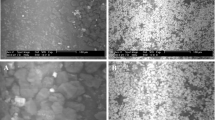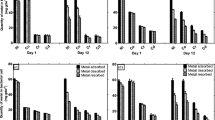Abstract
The effect of selected physical and chemical parameters, including media composition, uranium concentration, and metabolic inhibitors, on uranium uptake from aqueous solution by Chryseomonas sp. MGF-48, a bacterium isolated from electroplating effluent, was analysed. It was found that 198 mg/g (dry weight) of uranium was taken up from a 150 ppm (mg/l) solution of uranium when cells were maintained under starvation conditions. Uranium was released from the cells by addition of sodium carbonate. Uptake of uranium was reduced when cells were subjected to pretreatment with ultraviolet (u.v.) light (263.7 nm, 10 min) or heat (100 °C, 15 min), i.e., 99.8 and 57.5 mg/g, respectively. Addition of 2, 4-dinitrophenol (10 mM) or sodium azide (0.1%) resulted in decreased uptake (129 and 123 mg/g, respectively), whereas addition of glycerol-2-phosphate (G-2-P) resulted in deposition of uranium. Maximum uptake of uranium occurred at pH 6.5. Uranium uptake in the presence of selected carbohydrates decreased as follows: xylose > arabinose > mannose > maltose > glucose. When Chryseomonas sp. MGF-48 was exposed to 5, 50, or 100 mg/l uranium prior to uptake experiments, a decrease in uranium uptake was noted. Furthermore, immobilization of the bacterial cells in a calcium-alginate medium reduced the efficiency of uptake, yielding only 60% uranium uptake. It is concluded that uranium uptake and accumulation by this bacterium involves both metabolism-independent absorption and metabolism-dependent absorption, the former being considered to be more efficient.
Similar content being viewed by others
References
Akthar, N., Sastray, Md.S. & Mohan, M. 1995 Biosorption of silver ions by processed Aspergillus niger biomass. Biotechnology Letters 17, 551–556.
Akyil, S., Aslani, M.A.A., Ölmez, S. & Eral, M. 1996 Kinetic Studies of Uranium (VI) Adsorption on a Composite Ion Exchanger. Journal of Radioanalytical and Nuclear Chemistry Letters 213, 441–450.
Andrea, E. & Kunz, B. 1995 Biosorption of heavy metals by Saccharomyces cerevisiae: effects of nutrient conditions. Journal of Chemical Technology and Biotechnology 63, 257–261.
Bengtsson, L., Johansson, B., Hackett, T.S., McHale, L., & McHale, A.P. 1995 Studies on the biosorption of uranium by Talaromyces emersonii. Applied Microbiology and Biotechnology 42, 807–811.
Blackwell, K.J., Singleton, F.L. & Tobin, J.M. 1995 Metal cation uptake by yeast, a review. Applied Microbiology and Biotechnology 43, 579–584.
Brierley, J.A., Goyak, G.M. & Brierly, C.L. 1996 Considerations for commercial use of natural products for metals recovery. In Immobilisation of Ions by Bio-sorption, eds. Eccles, H. & Hunt, S. p. 105. Chichester: Ellis Horwood. ISBN 0-74580003-3.
Gadd, G. & White, C. 1993 Microbial treatment of metal pollution - a working biotechnology. Trends in Biotechnology 11, 353–359.
Leusch, A., Holan, Z.R. & Volesky, B. 1995 Biosorption of heavy metals (Cd, Cu. Ni, Pb, Zn) by chemically reinforced biomass of marine algae. Journal of Chemical Technology and Biotechnology 62, 279–288.
Malekzadeh, F., Farazmand, A., Ghafourian, H., Shahamat, M. & Colwell, R.R. 1994 Accumulation of uranium by Pseudomonas strain MGF-48, p. 355. 94th General Meeting, American Society for Microbiology.
Malekzadeh, F., Farazmand, A., Ghafourian, H., Shahamat, M., Levin, M., Grim, C. & Colwell, R.R. 1996 Accumulation of Heavy Metals by a Bacterium Isolated from Electroplating Effluent. In Proceedings of the Biotechnology Risk Assessment Symposium, June 23-25, 1996. Ottawa, Ontario, Canada, eds. Levin, M., Grim, C. & Angle, J.S., pp. 388–395. Biotechnology Risk Assessment: Risk Assessment Methodologies. University of Maryland BioTech. Inst., Baltimore, Maryland, Balmoral Press, Baltimore, Maryland.
Michel, L.J., Macaskie, L.E. & Dean, A.C.R. 1986 Cadmium accumulation by immobilized cells of a Citrobacter sp. using various phosphate donors. Biotechnology and Bioengineering 28, 1358–1365.
Naseem, A., Sastray, M.D.S. & Mohan, M. 1995 Biosorption of silver ions by processed Aspergillus niger biomass. Biotechnology Letters 17, 551–556.
Norris, P.R. 1979 Accumulation of metals by bacteria and yeasts. Industrial Microbiology 20, 299–308.
Rehm, H.J. & Read, G. 1988 Special Microbial Processes. mbH, In Biotechnology Vol. 6b, Weinheim, Germany: VCH-Verlagsgesellschaft. ISBN 0-89573413-3.
Silver, S. 1991 Bacterial heavy metal resistance systems and possibility of bioremediation. In Biotechnology: Bridging Research and Applications, eds. Kamely, D., Chakrabarty, A. & Kornguth, S.E. pp. 265–287. Boston: KluwerAcademic Publishers. ISBN 0-79231144-2.
Wilhelmi, B.S. & Duncan, J.R. 1995 Metal recovery from Saccharomyces cerevisiae biosorption columns. Biotechnology Letters 17, 1007–1012.
Wong, P.K. & So, C.M. 1993 Copperaccumulation by a strain of Pseudomonas putida. Microbios 73, 113–121.
Yong, P. & Macaskie, L.E. 1997 Removal of lanthanum, uranium and thorium from the citrate complexes by immobilized cells of Citrobacter sp. in a flow-through reactor: implications for the decontamination of solutions containing plutonium. Biotechnology Letters 19, 251–255.
Yves, A., MacCordick, H.J. & Hubert, S.C. 1993 Adsorption of several actidine (Th, 11) and lanthanide (La, Eu, Yb) ions by Mycobacterium smegmatis. Applied Microbiology and Biotechnology 39, 413–417.
Author information
Authors and Affiliations
Rights and permissions
About this article
Cite this article
Malekzadeh, F., Latifi, A., Shahamat, M. et al. Effects of selected physical and chemical parameters on uranium uptake by the bacterium Chryseomonas MGF-48. World Journal of Microbiology and Biotechnology 18, 599–602 (2002). https://doi.org/10.1023/A:1016806314721
Issue Date:
DOI: https://doi.org/10.1023/A:1016806314721




